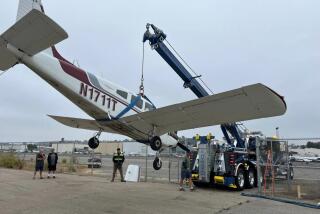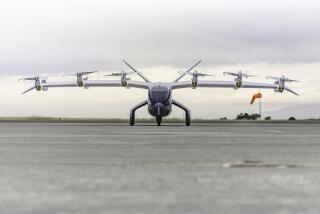Experimental Radar to Be Tested for Use in Searches, Rescues
An effort to tap advanced aerospace technology to conduct search-and-rescue operations over rugged mountains and other remote areas will be tested today over San Bernardino National Forest.
A DC-8 aircraft equipped with an experimental radar that can see through trees and bushes will fly over the forest looking for a small private plane that has been missing for nearly a year.
The scheduled test is the outgrowth of efforts by San Bernardino County Sheriff’s Lt. Mike Tuttle, who is president of the National Assn. for Search and Rescue.
Tuttle persuaded the National Aeronautics and Space Administration to test the new radar over the crash site.
“People don’t realize that not everyone dies on impact, and that there are many times when we just can’t flat locate them because of the terrain or because the brush is so thick,” he said. “With this technology, we’ll be able to locate them right away.”
Under the NASA plan, the DC-8, with a crew of 20 and filled with computers and other electronic equipment, will crisscross the mountains for nine hours. The plane will fly out of NASA’s Dryden Flight Research Center near Mojave.
The flight, which will begin tonight and cover a 360-square-mile area, will gather data that will be used to refine the system so that one day search-and-rescue teams can use the radar on a regular basis, said Walter Klein, NASA’s mission director for the radar test.
In June, a Piper Archer II piloted by 24-year-old Daniel Katz disappeared somewhere over the Lytle Creek area of the San Gabriel Mountains, part of the San Bernardino National Forest.
Extensive ground and aerial searches failed to turn up any clues to the plane’s whereabouts or the pilot’s fate. The search was hampered by rugged terrain and an extensive tree canopy.
NASA and San Bernardino County sheriff’s officials said today’s flight is mainly intended to test the radar for future use in search and rescue efforts. The test will be completed early Tuesday morning. “If the system functions as designed, we may find our missing aircraft,” Tuttle said.
Known as a synthetic aperture radar, the system can discern man-made objects even if covered under heavy foliage. Developed initially for spy agencies, the radar has been gaining attention for use in studying the environment as well as for use in search-and-rescue efforts.
Klein said data gathered during the flight will be used to refine computer software so the system can “decipher between an old refrigerator and an aircraft.”
Tuttle said the program began with a chance meeting in July. He flew to Washington, D.C., to talk to NASA employees about using the radar for search and rescue, but during the meeting, then-NASA director Daniel Goldin walked into the room and began hearing Tuttle’s proposal.
“He said he believed in the system and directed the employees to work with me right there on the spot,” Tuttle said.
More to Read
Sign up for Essential California
The most important California stories and recommendations in your inbox every morning.
You may occasionally receive promotional content from the Los Angeles Times.










